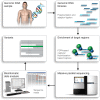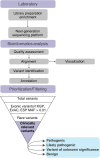Genetic advances in sarcomeric cardiomyopathies: state of the art
- PMID: 25634555
- PMCID: PMC4349164
- DOI: 10.1093/cvr/cvv025
Genetic advances in sarcomeric cardiomyopathies: state of the art
Abstract
Genetic studies in the 1980s and 1990s led to landmark discoveries that sarcomere mutations cause both hypertrophic and dilated cardiomyopathies. Sarcomere mutations also likely play a role in more complex phenotypes and overlap cardiomyopathies with features of hypertrophy, dilation, diastolic abnormalities, and non-compaction. Identification of the genetic cause of these important conditions provides unique opportunities to interrogate and characterize disease pathogenesis and pathophysiology, starting from the molecular level and expanding from there. With such insights, there is potential for clinical translation that may transform management of patients and families with inherited cardiomyopathies. If key pathways for disease development can be identified, they could potentially serve as targets for novel disease-modifying or disease-preventing therapies. By utilizing gene-based diagnostic testing, we can identify at-risk individuals prior to the onset of clinical disease, allowing for disease-modifying therapy to be initiated early in life, at a time that such treatment may be most successful. In this section, we review the current application of genetics in clinical management, focusing on hypertrophic cardiomyopathy as a paradigm; discuss state-of-the-art genetic testing technology; review emerging knowledge of gene expression in sarcomeric cardiomyopathies; and discuss both the prospects, as well as the challenges, of bringing genetics to medicine.
Keywords: Dilated cardiomyopathy; Genetics; Hypertrophic cardiomyopathy; Next Generation Sequencing; Sarcomere.
© The Author 2015. Published by Oxford University Press on behalf of the European Society of Cardiology.
Figures



References
-
- Geisterfer-Lowrance AA, Kass S, Tanigawa G, Vosberg HP, McKenna W, Seidman CE, Seidman JG. A molecular basis for familial hypertrophic cardiomyopathy: a beta cardiac myosin heavy chain gene missense mutation. Cell. 1990;62:999–1006. - PubMed
-
- Kamisago M, Sharma SD, DePalma SR, Solomon S, Sharma P, McDonough B, Smoot L, Mullen MP, Woolf PK, Wigle ED, Seidman JG, Seidman CE. Mutations in sarcomere protein genes as a cause of dilated cardiomyopathy. N Engl J Med. 2000;343:1688–1696. - PubMed
-
- McNally E, Dellefave L. Sarcomere mutations in cardiogenesis and ventricular noncompaction. Trends Cardiovasc Med. 2009;19:17–21. - PubMed
-
- Jarcho JA, McKenna W, Pare JA, Solomon SD, Holcombe RF, Dickie S, Levi T, Donis-Keller H, Seidman JG, Seidman CE. Mapping a gene for familial hypertrophic cardiomyopathy to chromosome 14q1. N Engl J Med. 1989;321:1372–1378. - PubMed
Publication types
MeSH terms
Substances
Grants and funding
LinkOut - more resources
Full Text Sources
Other Literature Sources
Medical

